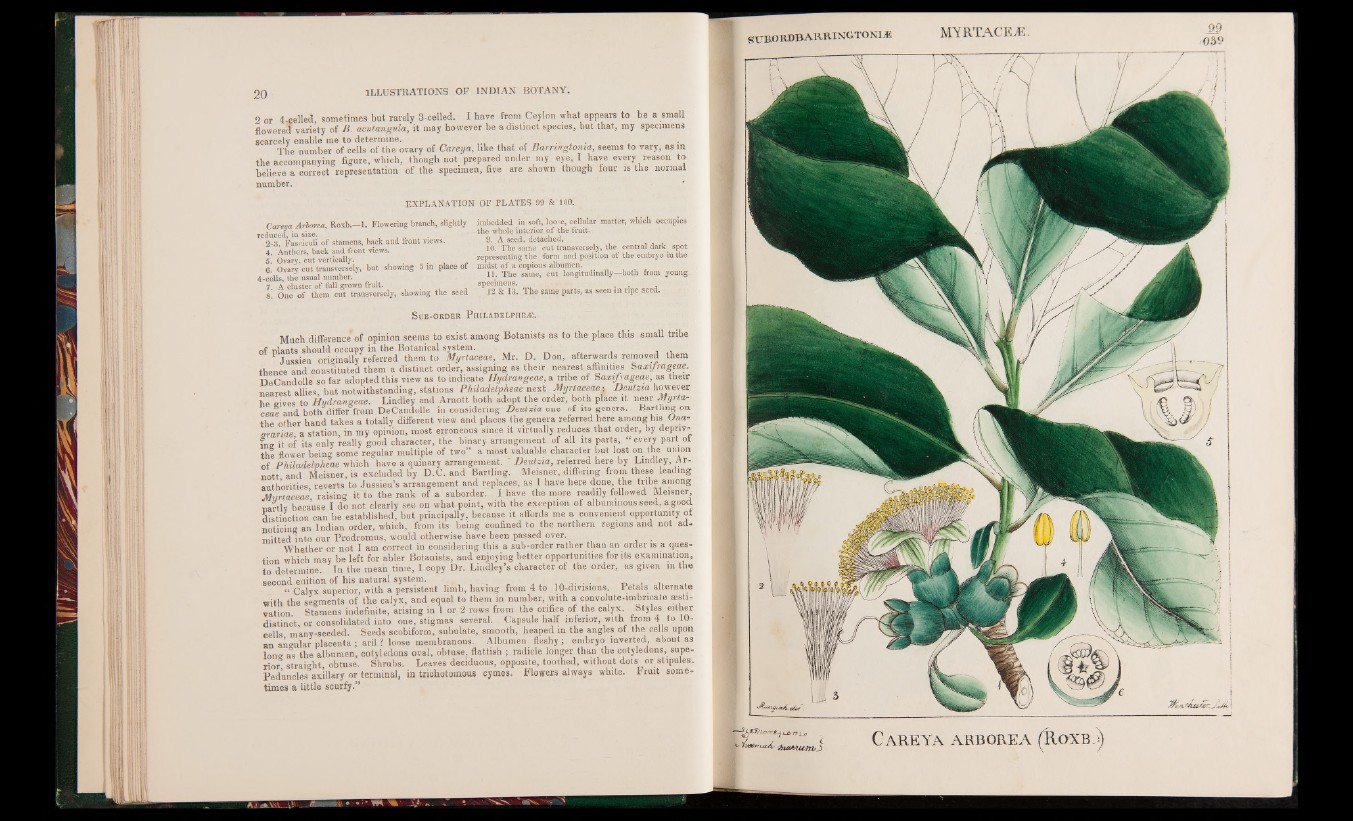
o or 4-nelled, sometimes but rarely 3-celIed. I have from Ceylon what appears to be a small
flowered variety of B. acutangula, it may however be a distinct species, but that, my specimens
scarcely enable me to determine. „ _ . I .
The number of cells of the ovary of Careya, like that of Barnngtoma, seems to vary, as in
the accompanying figure, which, though not prepared under my eye, I have every reason to
believe a correct representation of the specimen, five are shown though four is the normal
number.
EXPLANATION OF PLATES 99 & 100.'
Careya Arborea, Roxb.—1. Flowering branch, slightly
reduced, in size. _
2-3. Fasciculi of stamens, back and front views.
4. Antbers, back and front views.
5. Ovary, cut vertically. . .
6. Ovary cut transversely, but showing 5 m place ot
4-cells, the usual number.
7. A cluster of full grown fruit.
8. One o f them cut transversely, showing the seed
imbedded in soft, loose, cellular matter, which occupies
the whole interior, 'of the fruit.
9. A seed, detached.
lo! The same cut transversely, the central dark spot
representing the form and position of the embryo in the
midst o f a copious albumen.
11. The same, cut longitudinally—both from young
specimens.
12 & 13. The same parts, as seen in ripe seed.
S ub-o r d e r P h il a d e l ph e ^ j.
Much difference of opinion seems to exist among Botanists as to the place this small tribe
of Diants should occupy in the Botanical system. H|' - „ . , Rj F Jussieu originally referred them to Myrtaceae, Mr. D. Don, afterwards removed them
thence and constituted them a distinct order, assigning as their nearest affinities Saxifrageae.
DeCandolle so far adopted this view as to indicate Hydrartgeae, a tribe of Saxifrageae, as their
nearest allies but notwithstanding, stations Philadelpheae next Myrtaceae$ Deutzia however
he gives to Hydrangeae. Lindley and Arnott both adopt the order, both place it near Myrtaceae
and both differ from DeCandolle in consideringDeutzia one of its genera. Barthng on
the other hand takes a totally different view and places the genera referred here among his Una-
srariae a station, in my opinion, most erroneous since it virtually reduces that order, by depriving
it of its only really good character, the binary arrangement of all its parts, “ every part ot
the flower being some regular multiple of two” a most valuable, character but lost on the union
of Philadelpheae which have a quinary arrangement. * Deutzia, referred here by Lindley, Ar-
nott and Meisner, is excluded by D.C. and Bartling. Meisner, differing from these leading
authorities reverts to Jussieu’s arrangement and replaces, as l have here done, the tribe among
Myrtaceae raising it to the rank of a suborder. I have the more readily followed Meisner,
nartlv because I do not clearly see on what point, with the exception of albuminous seed, a good
distinction can be established, but principally, because it affords me a convenient opportunity ot
noticing an Indian order, which, from its being confined to the northern regions and not admitted
into our Prodromus, would otherwise have been passed over.
Whether or not I am correct in considering this a sub-order rather than an order is a ques-
tion which may be left for abler Botanists, and enjoying better opportunities for its examination,
to determine. In the mean time, I copy Dr. Lindley’s character of the order, as given m the
second edition of his natural system. .. -r. . i i, „
“ Calyx superior, with a persistent limb, having from 4 to 10-divisions. Petals alternate
with the segments of the calyx, and equal to them in number, with a convoJute-imbricate sesti-
vation Stamens indefinite, arising in l or 2-rows from the orifice of the calyx. Styles either
distinct, or consolidated into one, stigmas several. Capsule half inferior, with from 4 to 10-
cells many-seeded. Seeds scobiform, subulate, smooth, heaped in the angles of the cells upon
an angular placenta ; aril ? loose membranous. Albumen fleshy; embryo inverted, about as
long as the albumen, cotyledons oval, obtuse, flattish ; radicle longer than the cotyledons, superior
straight, obtuse. Shrubs. Leaves deciduous, opposite, toothed, without dois or stipules.
Peduncles axillary or terminal, in trichotomous cymes. Flowers always white. Fruit sometimes
a little scurfy.”
S U B .O R D B A R R IN C T O N IÆ MYRTACEÆ. W
0 39
|
ffllneÂùS-iér.MSh,